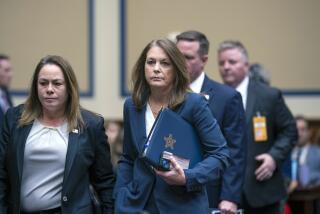Keep the Capitol’s Doors Open
- Share via
There’s plenty to regret in the shooting that left two heroic U.S. Capitol police officers dead Friday. What if the psychiatrists who examined the suspect, Russell Eugene Weston Jr., during a 1996 commitment to the Montana state mental hospital had found a way to keep him confined? What if, once he was released, a stronger mental health safety net had caught Weston’s rising paranoia and anger? His neighbors in Montana related how he complained that government agents were watching him and listening to his thoughts. What if the Secret Service had found him to be more than a low-level threat? What if he hadn’t had ready access to a handgun?
But at the crucial point, the Capitol’s security system did work. The suspect didn’t make it unnoticed past the metal detectors to hunt down whichever public official haunted his dreams. Police personnel were after him from the moment he tried to enter the building, with officer Jacob Chestnut shot to death as he ordered the suspect to pass through the detectors and officer John Gibson fatally shot in an exchange of gunfire soon afterward, at the nearby offices of Rep. Tom Delay (R-Texas).
Now, to their credit, most members of Congress have soundly rejected the sort of fortress security that surrounds the White House--the closed boulevards, high fences, checkpoints, sensors, highly controlled entry. Security has been tightened with each shooting incident and terrorist threat and, in 1994, the crash of a small plane on the White House grounds. Fencing the Capitol has been proposed and rebuffed more than once, although vehicle access is restricted.
A similar debate is still going on in Sacramento, where the Wilson administration has repeatedly proposed a stone and iron fence around the entire state Capitol. Each year, the Legislature--with the support of Sacramento city officials--has eliminated the fence funds from the state budget, but the idea was revived after Friday’s killings.
The California Highway Patrol, which is responsible for Capitol security, should take reasonable steps, perhaps including installing metal detectors at entrances and barriers in certain spots where vehicles can now drive up to doorways. But, just as in Washington, this is a people’s building and should remain as accessible as possible.
More to Read
Get the L.A. Times Politics newsletter
Deeply reported insights into legislation, politics and policy from Sacramento, Washington and beyond. In your inbox twice per week.
You may occasionally receive promotional content from the Los Angeles Times.










